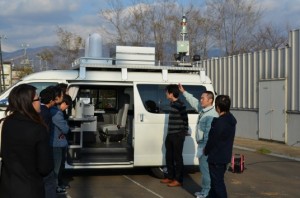Theme
Research on radioactive waste disposal systems
(Joint research by the Japan Atomic Energy Agency and private sectors)
(1) What is geological disposal of radioactive wastes?
The high-level radioactive wastes generated at nuclear power plants are disposed into stable bedrock deep underground after being solidified as an insoluble glassy material in an underground environment. In this case, to ensure long-term safety it is considered to pack the glassified wastes into a carbon steel container called an overpack and cover it with clay called a buffer material. The overpack seals in the solidified glass for over hundreds to a thousand years. On the other hand, the buffer materials not only relieve the mechanical stress caused by ground pressure but also stop the migration of ground water to delay the corrosion of the overpack. Also, it has a function of absorbing radioactive materials and delaying their migration. To evaluate the safety of such disposal systems, it is important to precisely evaluate the long-term performance of those solidified glasses, overpacks, and buffer materials.
(2) What are we researching on?
So far, human beings have not needed to predict the health and performance of the environmental materials of hundreds to tens of thousands years ahead, and have not had the means to do so. However, from now on we need to establish those technologies as soon as possible, since to stably take advantage of nuclear energy we need to dispose radioactive materials in a safe and reliable manner.
Our laboratory has been developing new engineering methodologies to predict the future of those materials. To predict the health and performance of the environmental materials of hundreds to tens of thousands years ahead, we need to strictly investigate the characteristics of those materials and gain deep understanding of the mechanisms of various reactions that occur in there. Also, we need to study the pros and cons of extending the time axis to the far future. To do so, we need to perform research using cutting-edge analysis technologies to grasp infinitesimal changes, and/or research based on new concepts.
Our current research interests related to radioactive waste disposal are as follows:
a) Elucidation of the behavior of migration of contaminants in environmental materials using a non-seal radioactive tracer
Through these researches, we have been performing characteristics evaluation of environmental materials used for processing/disposal of radioactive wastes, and their reaction mechanisms.
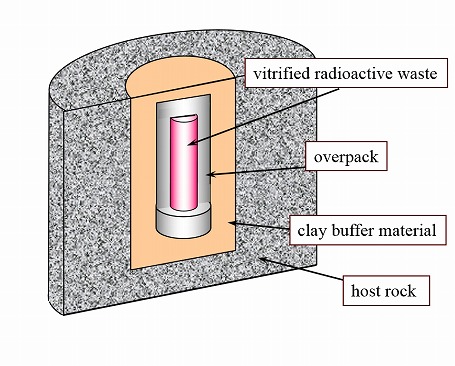 Conceptual diagram of geological disposal of high-level radioactive wastes
Conceptual diagram of geological disposal of high-level radioactive wastes
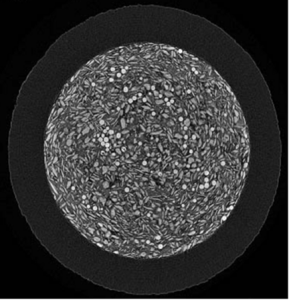 Internal structural observation of clay buffer materials by X-ray CT
Internal structural observation of clay buffer materials by X-ray CT
Research on the environmental restoration after the accident at the Fukushima Daiichi Nuclear Power Station --- aiming at revitalization of Fukushima
(Joint research project with the Japan Atomic Energy Agency)
(1) Decontamination wastes and decommissioning
Although the decontamination of the contaminated area is progressing, a huge amount of decontamination wastes has been generated through the decontamination activity. Characteristics evaluation of wastes is indispensable for proper intermediate storage and final disposal. Therefore it is important to understand the mechanisms of physical, chemical, biological behaviors of Cesium (Cs-134, Cs-137) in a soil. In contrast, to perform decommissioning of the Fukushima Daiichi Nuclear Power Station in a proper and reasonable manner, it is necessary to study technologies and expenses relevant to the reduction of radiation exposure to workers, the amount of generated wastes, cooperation with communities, and so on.
(2) Research activities
Although it is known that cesium strongly adsorbs to clay components in a soil, its mechanism is not fully elucidated yet. Furthermore, soils in nature are composites/mixtures of various inorganic minerals and organic matter including clay, and they are very complex systems where their composition and structure change over time by the mutual interaction among the component parts. In our laboratory, we are pursuing research on the behavior of cesium in a soil using both experimental and computational approaches. Our goal is to explain the phenomenon observed in a macroscopic scale utilizing microscopic-level theories. In contrast, in our research on decommissioning of the Fukushima Daiichi Nuclear Power Station, we are collecting fundamental data for analysis and evaluation of the technologies and expenses and studying analysis methodologies for them, considering the fact that the status of Fukushima’s reactor is greatly different from the one of nuclear facilities that lived out their life.
Our major research projects are as follows:
a) Research on the influence of organic matter on the behavior of sorption-desorption/migration of cesium in a soil
b) Analysis on technologies and expenses for decommissioning of nuclear facilities
As for the research on the behavior of sorption-desorption/migration of cesium in a soil, a joint research with Université de Nantes / Subatech is going on and we send intern students every year.
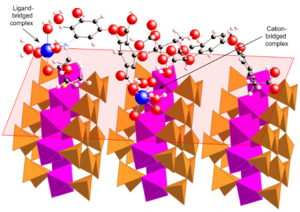 Simulation of the sorption behavior of Cs ions to the edge part of clay minerals by computational molecular dynamics
Simulation of the sorption behavior of Cs ions to the edge part of clay minerals by computational molecular dynamics
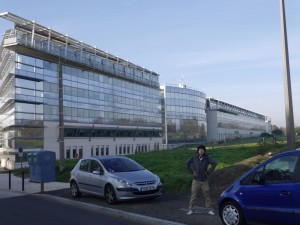 ・Subatech/Ecole des Mines, Université de Nantes (France), with which we are conducting joint research
・Subatech/Ecole des Mines, Université de Nantes (France), with which we are conducting joint research
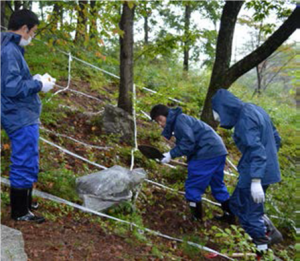 Scene of practical training on decontamination in Fukushima Prefecture (September 26th, 2013 in Iitate village)
Scene of practical training on decontamination in Fukushima Prefecture (September 26th, 2013 in Iitate village)
Cultivation of international human resources capable of handling a wide variety of environmental radioactivity problems through cooperation among organizations
To cope with various problems caused by the radioactivity released to the environment by the accident at the Fukushima Daiichi Nuclear Power Station, we need to cultivate human resources that have knowledge and skills on environmental radioactivity as soon as possible. Our laboratory has been receiving grants on promotion of human resources for nuclear power from the Ministry of Education, Culture, Sports, Science and Technology, and Prof. Kozaki, project representative, and his colleagues are pursuing the project “cultivation of international human resources capable of handling a wide variety of environmental radioactivity problems through cooperation among organizations”. We have been conducting lectures including experiments and/or fieldwork, seminars inviting overseas researchers playing an important role, and tours of relevant facilities, etc. having the cooperation with other universities, research institutes, local governments, and private sectors.
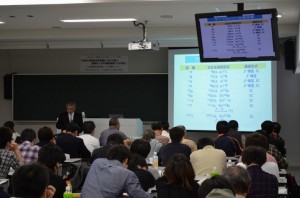 Lectures in beginner courses, intermediate courses, and advanced courses
Lectures in beginner courses, intermediate courses, and advanced courses
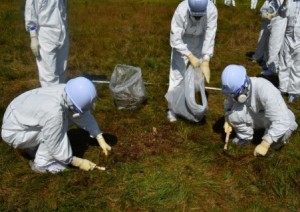 Practical training on decontamination in Fukushima Prefecture
Practical training on decontamination in Fukushima Prefecture
